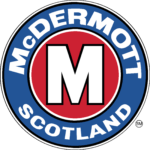The use of slipways enabled fabricated Jacket of Deck structures to be transferred or loaded out from an assembly location on the Yard onto a transportation barge by using a pair of land based and barge mounted skid rails which matched in terms of height and spacing. The Jacket or Deck Structure would be pulled or winched from land onto the barge in a process which took account of structure weights, barge size, ballasting requirements, tidal movements etc
For load out of the heaviest structures built on the Yard there were two sets of fixed Slipways erected with mounted skid rails, namely the Main (East) Slipway and the Secondary (West) Slipway.
The Main Slipways were constructed during the initial development of the yard and capable of loading out structures up to 30,000 Tonnes and were first used for assembly and loadout of the 14,500 Tonne Piper A Jacket in 1975. The heaviest structure to be skidded out on the Main Slipway was the 27,590 Tonne Murchison Jacket in 1979.
The Secondary Slipway was constructed in 1977 for the loadout of structures up to 15,000 Tonnes and was first used for the Namorado Jacket in 1978. The Secondary Slipway was later upgraded up to 20,000 Tonnes capacity, initially being used for the 19,200 Tonne NW Hutton Jacket in 1981 and later for the 20,000 Tonne Hutton TLP Integrated Deck in 1984. The TLP Deck was the only topside structure to be loaded out on either of these fixed slipways. A total of 13 structures were skidded out on the two sets of fixed slipways, 8 on the main and 5 on the secondary. The final time the fixed slipways were used was for the two Scott Field Jackets in 1992/1993, following this, structures were loaded out using either craneage or trailers.
